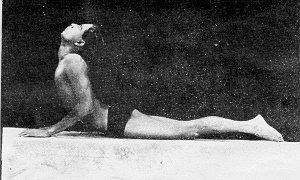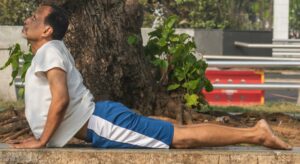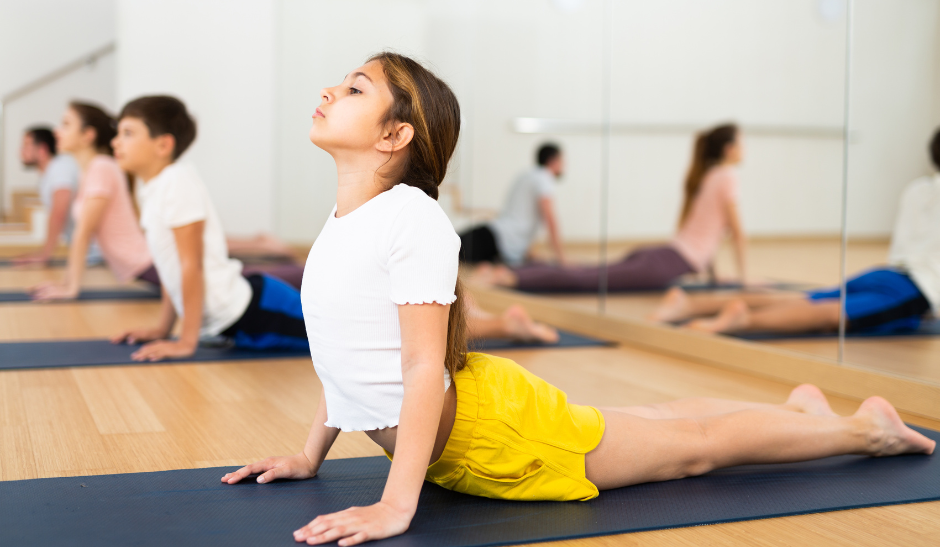What is bhujaṇgāsana (cobra pose)?
Bhujaṇgāsana or cobra pose is an āsana that increases the motility and rejuvenation of the entire spine and shoulders.
How do you practice bhujaṇgāsana technique?
- Sthithi (starting) position: First, lie down on your stomach, face down.
- Second, place hands under the shoulder joint, with elbows close to the body.

Bhujangasana – Cobra Pose - Third, keep the feet and knees together; relax the muscles in the back and abdomen. Now, inhale slowly.
- Next, exhale and push the torso up as far as possible, stretching the spine backward in a smooth, slow motion.
- Importantly, keep the hip firmly on the ground so that the lower hip and legs provide static resistance to the upward movement of the spine.
- Stretch the face as far as possible towards the ceiling. Maintain position for 10 counts.
- Slowly, inhale and return to original position. As you return, relax the deep and superficial muscles of the back, straightening the reverse bend of the vertebrae returning to correct position.
- Next, loosen the buttocks.
- Lastly, relax the sacral portion of the spine first, followed by the lumbar, thoracic and finally cervical region.
- Hold for 3-6 counts.
- Get the hands back to the sides.
- Finally, go back to sthithi (starting) position.
- Breathe normally. Repeat 3 to 6 times.
- The dṛṣṭi (gaze) recommended is urdhva-dṛṣṭi (open sky gaze).
What are the benefits of practicing bhujangāsana?
 First, the stretching action energises and strengthens the muscles of the back with increased blood supply and makes them supple, elastic and flexible.
First, the stretching action energises and strengthens the muscles of the back with increased blood supply and makes them supple, elastic and flexible.- Second, the spinal chord and cartilages get rejuvenated for the same reason. This exercise is very good for retaining the arch of the spine and prevents backache.
- Third, the flushing of the back with blood also tones up the sympathetic nervous system.
- Lastly, the pulling back action increases intra abdominal pressure, therefore is useful in all digestive ailments. Increased blood supply to the rectal muscles relieves constipation and reduces piles.
What are the possible bhujangāsana contraindications?
- Importantly, if you have any form of back ache, push yourself only to the point where there is no discomfort. When pain or discomfort starts, stop immediately. Over time and with practice, the back will begin to flex without pain.
- Practitioners suffering from kidney ailments and vertigo must also be careful not to strain beyond the limits of their bodies.
Some noteworthy points when performing bhujangāsana?
Internal Links: Dharma (conditioning), Stress and Situational Awareness, Prana, Asana overview 1, Asana Overview 2, Asana Focus or gazing, Pranayama, Hatha Yoga Pradeepika
External Links: Prana, Chakra, Pancha Tattva, Pancha Prana, Pancha Kosha, Nadi,
- Significantly, this āsana is considered to be one of the 32 most important āsana by all ancient texts.
- Importantly, those with cervical spondylosis should be careful when doing this āsana. Though it is good for lumbar spondylosis (lower back), it should not be done with any jerks.
- Also, in this āsana, it is important that the hand be used to push the torso upwards. This means that the sacral region of the spine is always in contact with the ground and the supine hip and legs provide the resistance to the upward movement of the torso. Therefore, the muscles of the spine are flexing with no motor stimulus. This increases blood supply to the lumbar, and cervical regions of the spine.
- Lastly, it is very important to keep the knees together for two reasons. First, when the lumbar area is arched backwards, the buttocks are squeezed together, increasing blood supply to the anal region. Second, the rearward movement increases blood supply to the sympathetic and para sympathetic nerves, rejuvenating the nerves in the lower back and legs.
